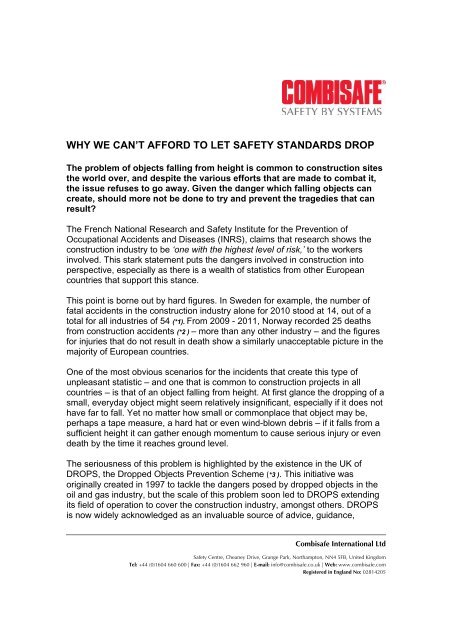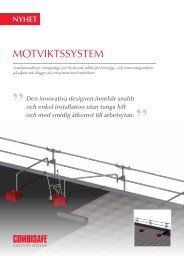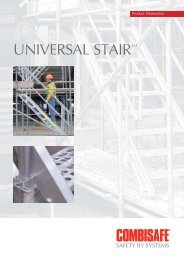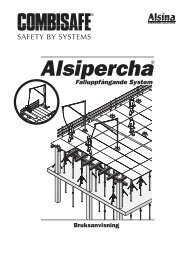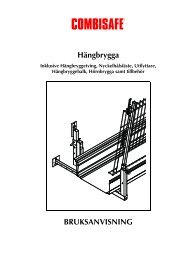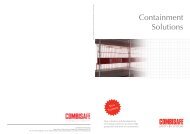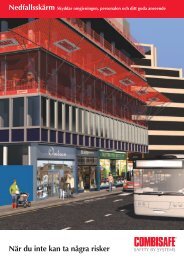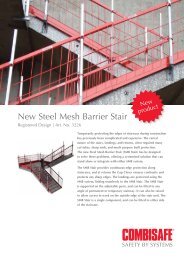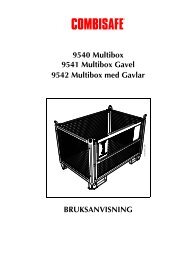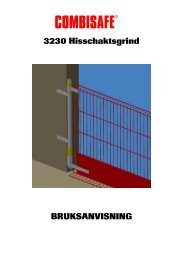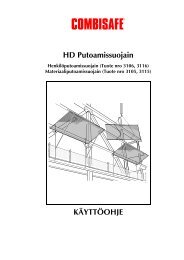why we can't afford to let safety standards drop - Combisafe
why we can't afford to let safety standards drop - Combisafe
why we can't afford to let safety standards drop - Combisafe
- No tags were found...
You also want an ePaper? Increase the reach of your titles
YUMPU automatically turns print PDFs into web optimized ePapers that Google loves.
WHY WE CAN’T AFFORD TO LET SAFETY STANDARDS DROPThe problem of objects falling from height is common <strong>to</strong> construction sitesthe world over, and despite the various efforts that are made <strong>to</strong> combat it,the issue refuses <strong>to</strong> go away. Given the danger which falling objects cancreate, should more not be done <strong>to</strong> try and prevent the tragedies that canresult?The French National Research and Safety Institute for the Prevention ofOccupational Accidents and Diseases (INRS), claims that research shows theconstruction industry <strong>to</strong> be ‘one with the highest level of risk,’ <strong>to</strong> the workersinvolved. This stark statement puts the dangers involved in construction in<strong>to</strong>perspective, especially as there is a <strong>we</strong>alth of statistics from other Europeancountries that support this stance.This point is borne out by hard figures. In S<strong>we</strong>den for example, the number offatal accidents in the construction industry alone for 2010 s<strong>to</strong>od at 14, out of a<strong>to</strong>tal for all industries of 54 (*1). From 2009 - 2011, Norway recorded 25 deathsfrom construction accidents (*2 ) – more than any other industry – and the figuresfor injuries that do not result in death show a similarly unacceptable picture in themajority of European countries.One of the most obvious scenarios for the incidents that create this type ofunpleasant statistic – and one that is common <strong>to</strong> construction projects in allcountries – is that of an object falling from height. At first glance the <strong>drop</strong>ping of asmall, everyday object might seem relatively insignificant, especially if it does nothave far <strong>to</strong> fall. Yet no matter how small or commonplace that object may be,perhaps a tape measure, a hard hat or even wind-blown debris – if it falls from asufficient height it can gather enough momentum <strong>to</strong> cause serious injury or evendeath by the time it reaches ground level.The seriousness of this problem is highlighted by the existence in the UK ofDROPS, the Dropped Objects Prevention Scheme (*3 ). This initiative wasoriginally created in 1997 <strong>to</strong> tackle the dangers posed by <strong>drop</strong>ped objects in theoil and gas industry, but the scale of this problem soon led <strong>to</strong> DROPS extendingits field of operation <strong>to</strong> cover the construction industry, amongst others. DROPSis now widely acknowledged as an invaluable source of advice, guidance,<strong>Combisafe</strong> International LtdSafety Centre, Cheaney Drive, Grange Park, Northamp<strong>to</strong>n, NN4 5FB, United KingdomTel: +44 (0)1604 660 600 | Fax: +44 (0)1604 662 960 | E-mail: info@combisafe.co.uk | Web: www.combisafe.comRegistered in England No: 02814205
training procedures and management systems that can be used <strong>to</strong> combat<strong>drop</strong>ped object accidents, and this indicates both the seriousness of this problemand the considerable resources that are devoted <strong>to</strong> tackling it.The responsibility for preventing accidents from falling objects is one that restsboth with the people who work at height and those who manage them, and if it isshared equally there is much that can be done.The process of reducing the danger should start right at the planning stage.Combining input from those who are managing the project, those who areproviding the <strong>safety</strong> equipment and those who are using it will help design a<strong>safety</strong> regime which will minimise the potential for <strong>drop</strong>ped and falling objectsright from the start. Some containment <strong>standards</strong> are available from individualsystem manufacturers and these offer excellent guidance when developing asuitable <strong>safety</strong> regime (*4).An assessment of the site itself should be comp<strong>let</strong>ed before work starts, so that asafe method of working can be devised which will reduce the potential risk. Thisshould include the opportunities for objects <strong>to</strong> be <strong>drop</strong>ped while working atheight, but also for debris being pushed or blown over the edge by the wind. Thisis especially relevant with <strong>to</strong>day’s increasingly high-rise projects where strongwinds may be especially prevalent. The safe method of working should then beimplemented, revie<strong>we</strong>d regularly throughout the duration of the project andcombined with effective management of those people working at height.Numerous measures can be employed <strong>to</strong> ensure that <strong>safety</strong> levels remain high.Regular input should be sought from everyone involved, and combined with othermore practical measures such as the tethering of <strong>to</strong>ols and the installation ofeffective protective equipment. There are many types of <strong>safety</strong> equipment whichcan be used, ranging from edge protection barriers, containment barriers, fullheight containment (including nets) and <strong>safety</strong> nets such as the <strong>Combisafe</strong>Safety Net Fan. Such measures should be considered as basic requirements, asbet<strong>we</strong>en them they serve <strong>to</strong> both prevent people, objects or debris falling overthe edge and also <strong>to</strong> arrest anything that does fall. In this way they provideessential protection for the people working at height and those below.Once work has started, people can quickly become complacent about <strong>safety</strong> and<strong>standards</strong> can begin <strong>to</strong> <strong>drop</strong>. Once again this highlights the need for againstfalling objects <strong>to</strong> be vie<strong>we</strong>d as a key and ongoing responsibility for everyoneinvolved.Although the type and size of construction projects undertaken throughoutEurope varies dramatically from region <strong>to</strong> region, statistics show clearly thataccidents do not respect international boundaries. For example, bet<strong>we</strong>en 2000<strong>Combisafe</strong> International LtdSafety Centre, Cheaney Drive, Grange Park, Northamp<strong>to</strong>n, NN4 5FB, United KingdomTel: +44 (0)1604 660 600 | Fax: +44 (0)1604 662 960 | E-mail: info@combisafe.co.uk | Web: www.combisafe.comRegistered in England No: 02814205
and 2009, the German construction industry was responsible for an average of22% of the country’s fatal industrial accidents (*5). The UK provides similarly grimfigures with 42 fatal injuries <strong>to</strong> construction workers in 2009/10 and 52 fatalities in2008/09 (*6).Faced with figures such as these <strong>we</strong> must all do whatever <strong>we</strong> can <strong>to</strong> reduce thenumber of deaths and serious injuries which occur on construction sites. Central<strong>to</strong> this is the issue of <strong>drop</strong>ped objects, and if <strong>we</strong> address this thoroughly andeffectively <strong>we</strong> will make a significant contribution <strong>to</strong>wards achieving thatimportant aim.ENDSSources:(*1) S<strong>we</strong>dish Work Environment Authority - www.av.se(*2) The Nor<strong>we</strong>gian Labour Inspection Authority - www.arbeidstilsynet.no(*3) DROPS - www.<strong>drop</strong>sonline.org(*4) As no recognised European Standard currently exists for containmentproducts, <strong>Combisafe</strong> developed its own, <strong>to</strong> create a basis of understanding.It specifies the requirements and test methods for containment systems inuse during construction or maintenance work and specifies therequirements for different zones, sizes of debris and wind classes(*5) Federal Institute for Occupational Safety and Health (BAuA)(*6) The UK Health and Safety Executive<strong>Combisafe</strong> InternationalFounded in S<strong>we</strong>den in the early 1980s, <strong>Combisafe</strong> has led the development of innovative <strong>safety</strong>at height solutions for over two decades. Responsible for developing and introducing a number ofrevolutionary new systems and products, <strong>Combisafe</strong> has been involved in a number of highprofile projects throughout the world, including The Shard in London, Vic<strong>to</strong>ria To<strong>we</strong>r in S<strong>to</strong>ckholmand Ferrari World in Abu Dhabi.<strong>Combisafe</strong> International LtdSafety Centre, Cheaney Drive, Grange Park, Northamp<strong>to</strong>n, NN4 5FB, United KingdomTel: +44 (0)1604 660 600 | Fax: +44 (0)1604 662 960 | E-mail: info@combisafe.co.uk | Web: www.combisafe.comRegistered in England No: 02814205
The company’s product range, much of which has become the benchmark for the industry,consists of fall prevention and protection solutions such as Steel Mesh Barriers and Safety NetFans, safe access solutions such as Site Stairways and specialist scaffolding systems includingUBIX® Temporary Roofing solutions.Products are designed <strong>to</strong> be user-friendly and cost-effective, whilst meeting the most stringent<strong>safety</strong> regulations and ultimately protecting workers and equipment from the risks of building atheight.The company, which is part of Honey<strong>we</strong>ll Life Safety, has offices throughout Europe, includingthe UK, S<strong>we</strong>den, Norway, Finland, France, Germany and the Netherlands as <strong>we</strong>ll as the MiddleEast.Offering specialist advice and support, combined with an ability <strong>to</strong> engineer solutions, <strong>Combisafe</strong>,with its unrivalled expertise and experience within the <strong>safety</strong> at height protection solutions sec<strong>to</strong>ris a true global leader.<strong>Combisafe</strong> International LtdSafety Centre, Cheaney Drive, Grange Park, Northamp<strong>to</strong>n, NN4 5FB, United KingdomTel: +44 (0)1604 660 600 | Fax: +44 (0)1604 662 960 | E-mail: info@combisafe.co.uk | Web: www.combisafe.comRegistered in England No: 02814205


